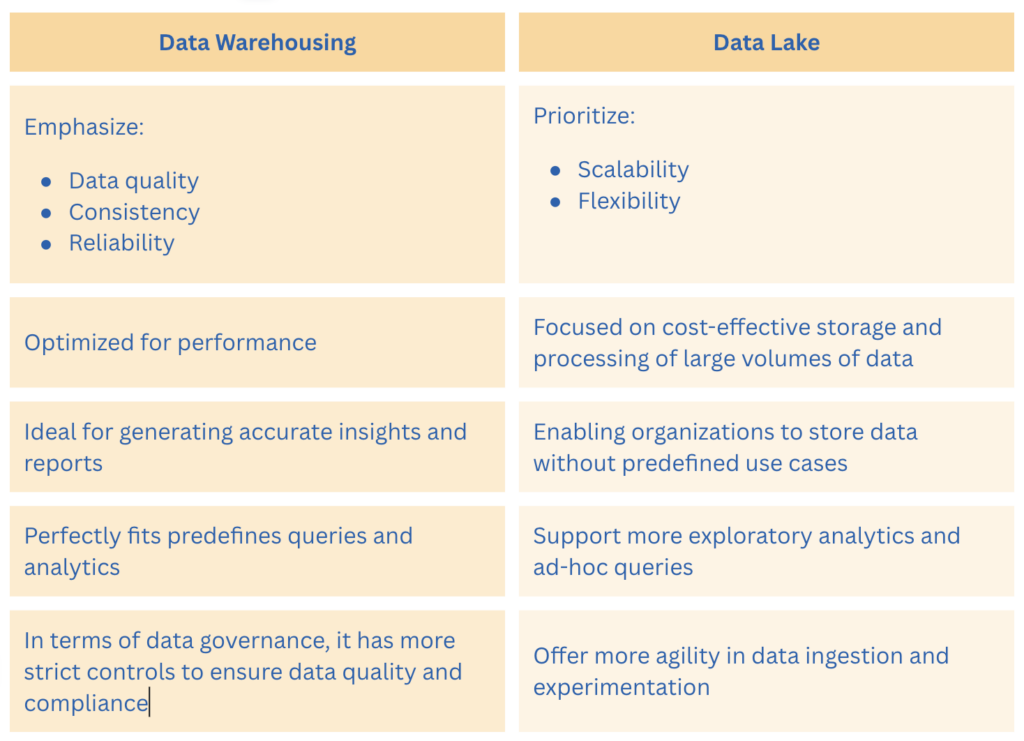As the difference between structured data and raw data is commonly known amongst the martech community, discussing the two concepts of data warehousing and data lakes is essential.
For business owners and managers who thrive on growth, successfully implementing techniques such as data warehousing will help them make better decisions, construct robust data strategies, and go the extra mile with their businesses and teams!
In this article, we will discuss the cornerstones of data warehousing, data warehouse architecture, and its evolution. We will also discuss how data analysis enables businesses to forecast future outcomes, mitigate risks, and capitalize on interesting market opportunities.
Data Warehousing: What is this? And how is it different from data lakes?
Defining Data Warehouse and Data Lake
Data warehouses work as a central repository for structured data. This data is collected from various sources, analyzed, and reported through the data warehouse.
Imagine the data warehouse as a library, organized and cataloged to guarantee easy access for responsible decision-makers and stakeholders. These types of systems are designed to enhance reporting and support business intelligence purposes.
On the other hand, data lakes are raw data stored in a structured, unstructured, or semi-structured format. They are more of a raw data dump stored for future use. Data lakes are more suitable for people who need flexibility with data exploration and analysis, i.e., data scientists.
Are we getting more technical?
The critical difference lies in their underlying structures. Data warehouses follow an approach where data is structured before it is stored. On the contrary, data lakes adopt a different approach where data can be structured when read.
Comparing the Functionalities of Data Warehousing and Data Lakes

Use Cases of Data Warehousing vs. Data Lakes
Understanding the nuances of data warehousing and data lake use cases is crucial for designing an effective data strategy that can achieve and satisfy certain outcomes.
Well… Industries such as finance, retail, and healthcare require the usage of structured data analysis. Hence, data warehouses are fundamental in providing historical data for forecasting, trend analysis, and decision-making.
Data warehouses are organizations’ go-to option to derive business intelligence efficiently from structured data. In contrast, data lakes are famous within the research, IoT, and big data domains.
These projects focus on future processing of unstructured and raw data in storage. This type of tool is more suitable for data science projects that revolve around exploratory data analysis.
Exploring the Architecture of Modern Data Warehouses
What are the core components of data warehouse architecture?
To store, analyze, and manage data effectively, many key components should harmoniously work together to form the core of a modern data warehouse. These components include:
- Data sources,
- ETL processes for data integration purposes,
- OLAP cubes for multidimensional analysis, and
- A relational database for structured data storage.
Data marts are a feature of data warehouses–they are subsets of the leading data warehouses tailored for specific business departments. Data marts help improve:
- Query performance, and
- Simplifying access to relevant data for end-users.
Not only that, but modern data warehouse architecture is also evolving enough to incorporate cloud-based technologies. This provides companies with many qualities, such as:
- Scalability,
- Flexibility, and
- Cost-efficiency.
By adopting modern data warehouse architecture, businesses can improve their data processing capabilities and unlock valuable insights for strategic decision-making. When integrated and implemented successfully, the benefits of cloud data warehouses should qualify organizations to meet the growing demand for storing and analyzing vast amounts of data in a real-time frame.
The Functional Role of Data Marts in Data Warehousing
The term “data marts” refers to specialized subsets designed to cater to specific and on-demand business requirements. Entities can streamline access for targeted analysis and reporting by organizing data into separate marts based on department or function.
By providing customized datasets to different user groups, data marts play a vital role in facilitating data accessibility and usability within organizations. This empowers decision-makers to base their decisions on accurate data and information in all areas of operations.
Moreover, data marts help in optimizing data processing workflows and promoting self-service analytics, leading to improved efficiency and effectiveness in leveraging data for strategic purposes.
The Evolution Journey of Data Warehouse Architecture
To meet the dynamic needs of businesses today, data warehouse architecture has evolved and shifted towards delivering more agile and scalable solutions. Old-fashioned data warehouses were typically on-premises, requiring significant hardware investments and regular maintenance costs.
While everything tech-related is evolving, and with advancements in cloud computing, organizations are migrating to cloud-based data warehouse solutions. This ensures improved performance, much-wanted flexibility, and–of course–cost reduction.
Cloud data warehouses offer extensive advantages such as:
- On-demand scalability
- Pay-as-you-go pricing plans
- flawless integration with the other cloud services
Data warehouses enable businesses to have a competitive edge in today’s data-driven world while driving innovation through advanced analytics capabilities. Cloud data warehouses offer advanced security features, data encryption, and automated backups that safeguard sensitive information and ensure regulatory data compliance.
Cloud Data Warehousing–Revolutionize Data Analysis and Storage
AWS Redshift, Azure Synapse Analytics, and Google BigQuery are prominent key providers for cloud-based data warehouses.
Despite their seamless data management and analysis capabilities, robust integration for data warehouses should be ensured by organizations. Data consistency, governance and compatibility when data is migrated, are all signs of a successful execution.
Pro Tip: when implementing a data warehouse, always choose the Consultants!
Businesses can unlock the full potential of their data assets, streamline the workflows of analytics, and drive business innovation through cloud-based solutions by adopting best practices in data integration. The process of data integration includes extracting, transforming, and efficiently loading ETL data from on-premises systems to cloud data warehouses.
Optimizing Data Strategies for Businesses Using Data Warehouses
Advanced data analytics techniques help companies to predict future outcomes, recommend optimal actions, and automate the process of decision-making. These techniques include predictive analytics, prescriptive analytics, and machine learning.
Data warehouses empower organizations to gain a comprehensive view of their operations, market trends, and customer behavior–this is achieved through assembling data from various sources and analyzing it.
All in all, data analytics help identifying opportunities, optimizing operational efficiency, and boost customer satisfaction and experience by following a fierce data driven measurement strategy.
To achieve every business’s goal–increase customer engagement rate and sales conversions, global e-commerce giants utilize the data warehouse’s data analytics to personalize product recommendations. Such successful businesses leverage the services of a data consulting company, such as e-CENS, where they can depend on accurately-driven data analytic models and reports.




